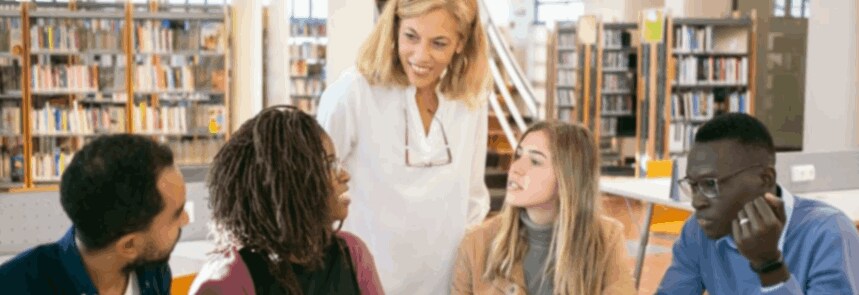
- Teaching trends and techniques
- Language teaching
Fostering critical thinking in the classroom
Critical thinking is a term often thrown around the teacher’s lounge. You often hear, “Of course, teaching critical thinking is essential.” However, in that same space, we may also hear the question, “But how?”
Teaching students to think critically involves helping them to develop a critical mindset. What exactly does that mean, and how can we do that?
What does it mean to think critically?
Critical thinking is a complex process that involves students reflecting, analyzing and evaluating ideas. Building a community of critical thinkers in our classrooms involves going beyond the cognitive domains and building the affective domains.
The cognitive domain concerns subject knowledge and intellectual skills, whereas the affective domain involves emotional engagement with an idea or learning material.
This deliberate teaching of critical thinking needs to be part of our teaching toolkit. We need to develop a mindset around it in and out of our classrooms.
How can teachers develop a critical-thinking mindset?
Consider all the questions we pose to students during our classes. Do we expect a yes or no answer, or have we established a classroom environment where students offer considered reasons for their responses?
By following some guiding principles, we can get into the practice of naturally expecting deeper answers:
- Students need to engage in critical thinking tasks/activities at all levels.
- Teachers need to provide space/time in the classroom to build critical thinking learning opportunities.
- Practicing critical thinking must be incorporated throughout the course, increasing complexity as students improve their critical thinking ability.
- Students must be given opportunities to practice transferring critical thinking skills to other contexts.
Activities to foster critical thinking in the classroom
Activity/Strategy #1: Categorizing
Provide a set of vocabulary terms or grammatical structures on the board (or pictures for true beginners). Ask your students to gather in pairs or small groups and have them categorize the list. Ask them to be creative and see how diverse the categories can be.
Example:
Desk, computer, pencil, stove, dishes, forks, novel, cookbook, sink, shelf
- Made from trees: pencil, novel, cookbook, desk.
- Made from metal: fork, stove, sink, etc.
Activity/Strategy #2: What’s the problem?
Provide students with a short reading or listening and have your students define a problem they read or hear.
Tomas ran up the steps into Building A. The door was closed, but he opened it up. He was very late. He took his seat, feeling out of breath.
- Determine why Tomas was late.
- Underline verbs in the past tense.
- Create a beginning or ending to the story.
Activity/Strategy #3: Circles of possibility
Present a problem or situation. Consider the problem presented in strategy #2 above: Ask the students to evaluate the situation from Tomas’ point of view, then, from the teacher’s point of view, and then from his classmate’s point of view.
This activity generates many conversations, and even more critical thinking than you can imagine!
Activity/Strategy #4: Draw connections
Provide students with a list of topics or themes they have studied or are interested in. Place one in the center, and ask them to draw connections between each one.
Afterward, they should explain their ideas. For example:
“Energy and environment are affected by sports. Most sports do not harm the environment, but if you think about auto racing, it uses a lot of fuel. It can negatively impact the environment.”
Activity/Strategy #5: What’s the rule?
Play students an audio clip or provide them with a reading text. Draw students’ attention to a particular grammatical structure and ask them to deduce the rules.
Activity/Strategy #5: Establishing context
Show your class an image and put your students in small groups. Give each group a task. For example:
The Jamestown settlement in the United States
“A famous historic site is the Jamestown Settlement in Virginia. People from England were the first people to live in Jamestown. When did they arrive? They arrived in 1607. They built homes and other buildings. They looked for gold, silver and other materials. They sent the materials back to England. It was a hard life. Jamestown wasn’t a good place to settle. The winters were cold, and the settlers didn’t know how to protect themselves. After some time, they traded with the Native Americans, including tools for food. This helped the hungry settlers. Did many people die? Yes, many of the first settlers died. Later, more settlers arrived in Jamestown. It wasn’t easy, but in the end the settlement grew.”
Ask questions like this:
- If this were in a movie, what would the movie be about?
- If this were an advertisement, what would it be advertising?
- If this were a book, what would the book be about?
There are many other wonderful strategies that can help build a classroom of critical thinkers. Getting your students accustomed to these types of tasks can increase their linguistic and affective competencies and critical thinking. In addition to these on-the-spot activities, consider building in project-based learning.
How can you incorporate project-based learning into your classroom?
Project-based learning often begins with a challenge or problem. Students explore and find answers over an extended period of time. These projects focus on building 21st Century Skills: Communication, Creativity, Collaboration, and Critical Thinking.
They also represent what students are likely to encounter when they leave our English language classes.
An example project
Consider this project: Our cafeteria is outdated. It does not allow for food variety, or for guests to sit in groups of their desired size and activity level. Survey students who use the cafeteria. Follow up the survey with interviews. Determine how your group can reimagine the cafeteria. Prepare a proposal. Present your proposal.
You can imagine the amount of language students will use working on this project, while, at the same time, building a critical mindset.
Teaching critical thinking is all about building activities and strategies that become part of your teaching toolkit, and your students’ regular approach to problem-solving.






